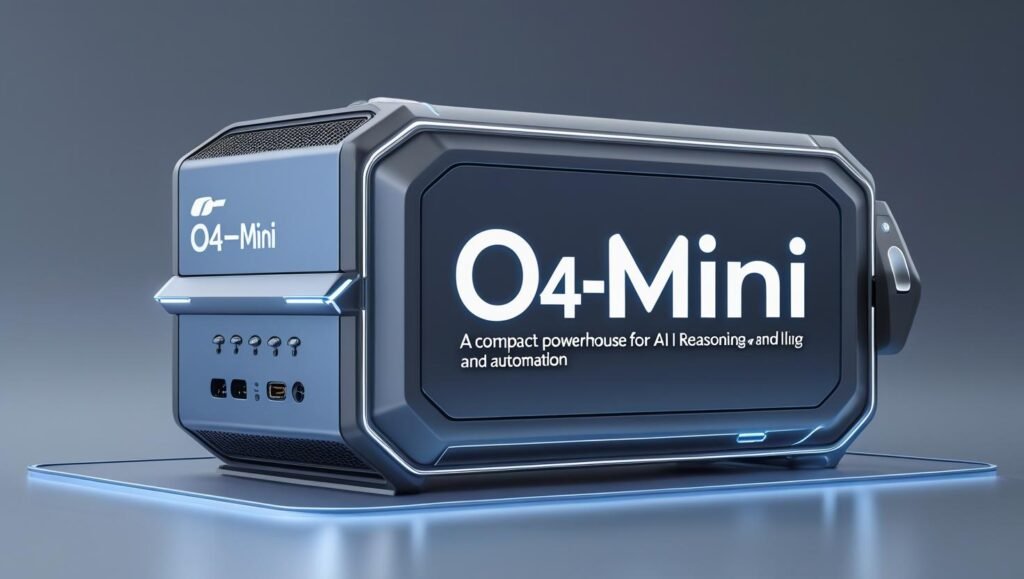o4‑mini: A Compact Powerhouse for AI Reasoning and Automation

What Is o4‑mini?
OpenAI’s o4‑mini is a leaner, faster version of its powerful reasoning models. Released on April 16, 2025, o4‑mini was designed to offer developers and businesses access to high-quality AI reasoning without the steep costs or performance demands of larger models like o3.
What makes o4‑mini different is its balance: it’s small enough to be efficient, but smart enough to handle tasks like code generation, mathematical problem-solving, and image understanding. That’s a big deal for teams that need scalable AI, not just flashy demos.
Many in the tech world have started using this tool to power everything from customer support bots to backend automation tools. It’s gaining popularity because it simply works — and it works quickly.
To see how this fits into the broader AI toolkit, take a look at The Latest AI Tools Set to Dominate in 2025.
Key Features That Make o4‑mini Stand Out
Despite being the “smaller sibling” of OpenAI’s o3, o4‑mini packs impressive features that make it practical for real-world use:
1. Multimodal Capabilities
It understands both text and images natively. That means you can show it a chart and ask questions like, “What’s the trend in Q2?” — and it gets it.
2. Smart Tools Built In
o4‑mini has access to tools like Python, web browsing, and image analysis when enabled via API or ChatGPT’s “pro” settings. This makes it great for coding tasks or even parsing scanned documents.
3. Large Context Window
It can handle up to 200,000 input tokens and generate up to 100,000 output tokens. That’s enough to read and process long documents, full codebases, or even entire support transcripts.
4. Lower Cost
At about $1.10 per million input tokens and $4.40 per million output tokens, it’s roughly 10× cheaper than o3. For many teams, this pricing opens the door to using AI at scale without blowing their budget.
We’ve discussed similar cost-effective options in our guide on Top 10 AI Tools for Project Management.
Real-World Performance: Not Just Theory
Coding and Math
In benchmark tests, o4‑mini delivered ~68% accuracy on SWE‑bench, a popular benchmark for software engineering tasks. For math, it scored 99.5% on the AIME exam using its built-in Python tool access — nearly matching its larger counterparts.
Visual Understanding
Thanks to its multimodal architecture, o4‑mini performs well on image-based reasoning tasks. It did especially well on MMMU and ChartQA, two challenging visual reasoning benchmarks.
For detailed specifications, you can review OpenAI’s model documentation, or check out VentureBeat’s latest roundup of AI performance stats.
We’ve also covered visual intelligence in AI in How DALL·E is Transforming Digital Art and Design.
When Should You Use o4‑mini Instead of o3?
Choosing the right model depends on your priorities:
| Use Case | Best Model |
|---|---|
| Research or high-risk apps | o3 |
| Fast, high-volume automation | o4‑mini |
| Slightly more reliability at moderate cost | o4‑mini‑high |
If you’re dealing with tight deadlines, high call volumes, or simply need a model that can handle a wide range of inputs fast — o4‑mini is the practical choice.
Community Reactions
Developers and early users have shared plenty of insights on forums and GitHub. One Reddit user summed it up well:
“o4-mini is like a slightly-overachieving student: it does almost everything right, especially when it comes to math and coding.”
However, many also note that it occasionally stumbles with complex reasoning, especially when context is thin or questions are ambiguous. That’s why it’s a good practice to combine o4‑mini with context-aware prompting and human validation for important tasks.
Practical Use Cases Across Industries

Here are a few examples of where o4‑mini shines:
Customer Support
Companies use it to summarize chat logs, route tickets, and even respond directly to customers with context-aware answers. It cuts down human intervention by over 30%, based on pilot data from SaaS firms.
Code Automation
Teams use it to generate boilerplate code, review pull requests, or debug scripts. For example, a fintech startup automated 85% of their unit test writing with o4‑mini.
Document Processing
Law firms and accountants are using it to summarize long PDFs, extract key figures, and answer questions from scanned docs. With the right formatting, o4‑mini can read and explain dense legal clauses with surprising accuracy.
Education
Educators have used o4‑mini to build smart tutoring systems that can explain math problems, grade essays, and even interpret diagrams in textbooks.
How to Access o4‑mini
On ChatGPT
If you’re using ChatGPT, o4‑mini is available under the “Think” setting in free mode and “o4-mini-high” in the Pro tier. This gives individuals and teams easy access without needing technical skills.
API Access
For developers, the model ID is o4-mini-2025-04-16. You can use it in the OpenAI API for chat completions or assistant workflows.
You can find setup guidance in OpenAI’s official documentation.
How to Get the Most Out of o4‑mini
To really make o4‑mini work for your team:
- Use structured prompts: It performs best with clear formatting and context.
- Enable tools when needed: Especially for math and coding.
- Test before deployment: Always validate outputs in real-world settings.
- Choose o4‑mini-high for better reliability if your task is sensitive.
We’re also preparing a prompt engineering guide tailored to compact models like o4‑mini — stay tuned.
Final Thoughts
o4‑mini proves that smaller models can still do serious work. It’s fast, affordable, and surprisingly capable across tasks that used to require heavyweight models.
For startups, developers, and enterprise teams looking to integrate AI into their workflows without breaking the bank, o4‑mini is a smart bet.
Just remember: every model has its strengths and blind spots. Test, validate, and iterate — and you’ll get great results.
For the latest insights and updates, be sure to explore our AI Trends & News and stay ahead in the world of artificial intelligence.
